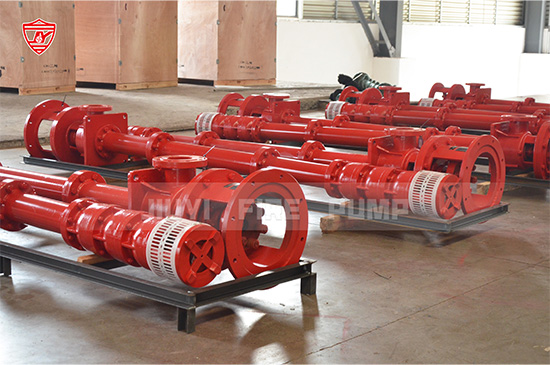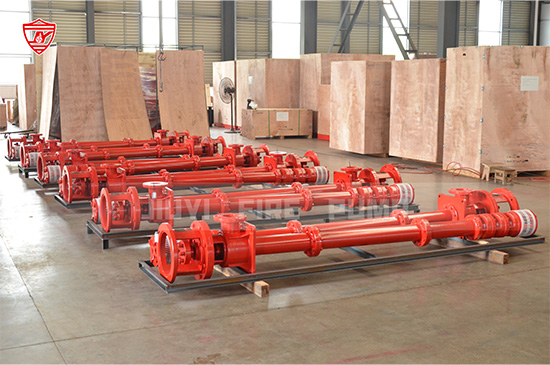A vertical turbine fire pump is a critical component in many fire suppression systems, designed to deliver high-pressure water from deep suction sources like underground reservoirs, wells, or tanks. Manufacturers rely on these pumps for installations where space is limited or where horizontal pumps are impractical.
This guide covers:
the definition and core function of a vertical turbine fire pump,
how it differs from other fire pump types,
key benefits and typical applications,
design considerations, installation tips, and maintenance best practices.
Whether you're exploring new product lines or educating your clients, understanding the ins and outs of vertical turbine fire pumps is essential to making informed decisions and optimizing fire protection systems.

A vertical turbine fire pump is a multi-stage centrifugal pump vertically oriented. Unlike horizontal split-case or inline pumps, it has its motor mounted above ground, while the pump stages are placed below in a well, dry pit, or wet pit assembly.
Key Components:
Discharge Head & Motor (Above Ground): Includes the driver (electric motor or diesel engine) and controls.
Column Pipe: A vertical shaft enclosing the pump shaft; contains bearings and delivers power to impellers.
Pump Stages (Below Ground): Series of impellers housed within tapered diffusers, submerged in water.
Suction Basin (Wet Pit): Where the bottom stage draws water.
Coupling & Seal System: Connects motor shaft to pump; may be sealed or open.
These pumps are commonly used for deep-water suction fueling their ability to lift from significant depths, up to 25 feet or more, depending on design, with typical lifts up to 50 ft (15 m).
Comparison to Horizontal Split-Case & Inline Pumps:
| Feature | Vertical Turbine Pump | Horizontal Split-Case Pump | Vertical Inline Pump |
|---|---|---|---|
| Orientation | Vertical (motor above, pump below) | Horizontal | Vertical, but pump above suction |
| Suction Configuration | Deep well, wet/dry pit | Ground-level reservoir | Ground-level reservoir |
| Footprint | Small, due to vertical column | Larger on footprint | Compact, but limited lift |
| Priming | Self-priming if in wet pit | Requires priming | May need priming |
| Maintenance Access | Motor above, stages below through pit | Entire pump accessible | Entire pump accessible |
Vertical turbine pumps excel in installations where building constraints prevent horizontal layouts, or where vertical lift from a deep source is needed.
Compact Design: The vertical orientation and narrow column minimize floor space requirements—beneficial for cramped pump rooms or mechanical vaults.
Deep Suction Capability: Can lift water from wells or below-ground tanks that horizontal pumps can't reach.
Flood Resistance: Since the driver is above ground and pump stages submerged or contained, there's reduced risk of flood damage.
Efficient Multistage Performance: Multiple stages boost pressure incrementally with high efficiency, ideal for delivering high-head water.
Ease of Maintenance: Motor and controls are easily accessible. Pump components are serviceable via the pit without extensive disassembly.
Versatility: Usable in wet-pit, dry-pit, or well configurations—accommodating diverse architectural and site demands.
Compliance & Reliability: Many vertical turbine fire pumps are NFPA 20–certified, ensuring reliability in fire protection.
These advantages make vertical turbine fire pumps indispensable in industries like municipal water systems, high-rise buildings, oil & gas, and agricultural irrigation.
Municipal & Industrial Water Supply: Serving as high-lift pumps from deep reservoirs or retention ponds.
Fire Protection in High-Rise Buildings: When underground tanks or vaults are used for water supply, vertical turbine pumps are ideal.
Oil & Gas Facilities: Often deploy these pumps for fire-water systems drawing from open pits or ponds.
Agriculture & Irrigation: Durable and capable of heavy workloads and variable intake conditions.
Remote/Unmanned Sites: Motor positioned above ground and robust design allow for reliable remote operation.
When engineering or selecting a vertical turbine fire pump, consider:
NFPA 20 Compliance: Ensure chosen model meets NFPA 20 standards for fire pump performance, driver type, control options, and acceptance testing; key for fire insurance and inspection approvals.
Pump Capacity & Head Requirements: Choose based on required flow (e.g., GPM/liter-per-minute) and total dynamic head. Multistage configurations can be tailored to specific head/flow demands.
Suction Lift Depth: Confirm pump’s rated net positive suction head (NPSH) and lift. Column pipe length must match pit depth; deeper installations require longer assemblies.
Driver Options: Electric motors are common; diesel drivers are selected for redundancy or where power reliability is uncertain.
Pit Type:
Wet Pit: Simplest—pump is submerged in static water; requires screened basin to prevent clogging.
Dry Pit: Pump is located in a dry vault with separate water supply; allows access but adds complexity.
Intake Filtration & Flood Prevention: Include suction strainers, screens, and pit design to prevent debris and facilitate cleaning.
Cooling & Sealing Systems: Ensure engine cooling capacity or motor venting; shaft seals must prevent contaminants and handle variable water levels.
Accessibility & Safety: Consider catwalks, access hatches, crane or hoist systems for maintenance; include safety railings and lighting.
Material Selection: Use corrosion-resistant materials—bronze, stainless steel, cast iron, or composite coatings—especially for harsh environments.
Instrumentation & Controls: Integrate pressure sensors, flow meters, redundant start circuitry, and fire pump controllers per NFPA 20.
Ensure Proper NPSH & Suction Conditions: Avoid cavitation by maintaining adequate suction head and water quality.
Base & Alignment: Install a robust concrete base; align pump and motor with precision to prevent alignment-related failures.
Check Column Plumbness: The vertical column must be perfectly plumb; misalignment strains bearings and shaft seals.
Pilot Piping & Valves: Provide properly sized check valves, control valves, and drain lines; ensure they meet NFPA emergency readiness standards.
Control Room Layout: Position control panels for easy monitoring. Include alarms, remote start capability, and clear operating instructions.
Commissioning & Testing: Conduct factory acceptance tests and performance curves. Perform annual flow testing per NFPA 25, ensuring pump meets rated performance when needed.
Water Quality Management: Keep suction water free of sediment; schedule basin cleaning; use filtration and regular inspection.
Routine Maintenance:
Monthly/Quarterly: Check motor condition, alignment, lubrication, pit water level, control panel indicators.
Annual Inspection: Drain pit, inspect impellers, bearings, column shaft; clean intake screens; test seals.
Operational Tests: Simulate fire demand periodically—observe pressure, flow, discharge conditions; ensure start-up reliability.
Lubrication & Seal Checks: Replace shaft packing or mechanical seals per schedule; inspect column bearings for wear.
Common Troubleshooting Scenarios:
Low Flow / Pressure: Could indicate clogged intake, worn impellers, cavitation due to poor NPSH, or blocked discharge.
Vibration / Noise: Often caused by misalignment, worn bearings, imbalance, or debris in impellers.
Seal Leakage: Shaft seal issues may stem from abrasive particles, worn packing, or improper installation.
Pump Fails to Start: Check control wiring, engine battery (for diesel), motor fuses, or fire pump controller faults.

A vertical turbine fire pump is a versatile and efficient solution in many fire protection and water systems, particularly in situations where vertical lift, compact footprint, and flood resilience are crucial. Understanding what it is, how it operates, its advantages, and proper installation and maintenance are vital for manufacturers and system designers aiming to deliver high-performance, reliable fire safety systems.
As a fire pump manufacturer, your ability to articulate these benefits clearly—not only in product specs but in educational content—builds trust and authority among customers, engineers, and specifiers. By pairing robust technical knowledge with SEO-optimized content (targeting keywords like vertical turbine fire pump), you boost both discoverability and credibility.